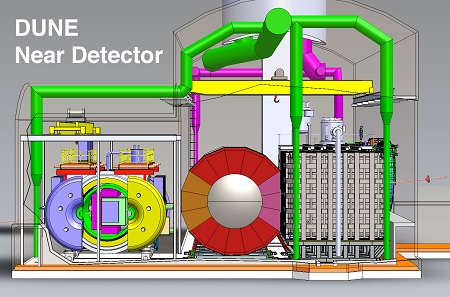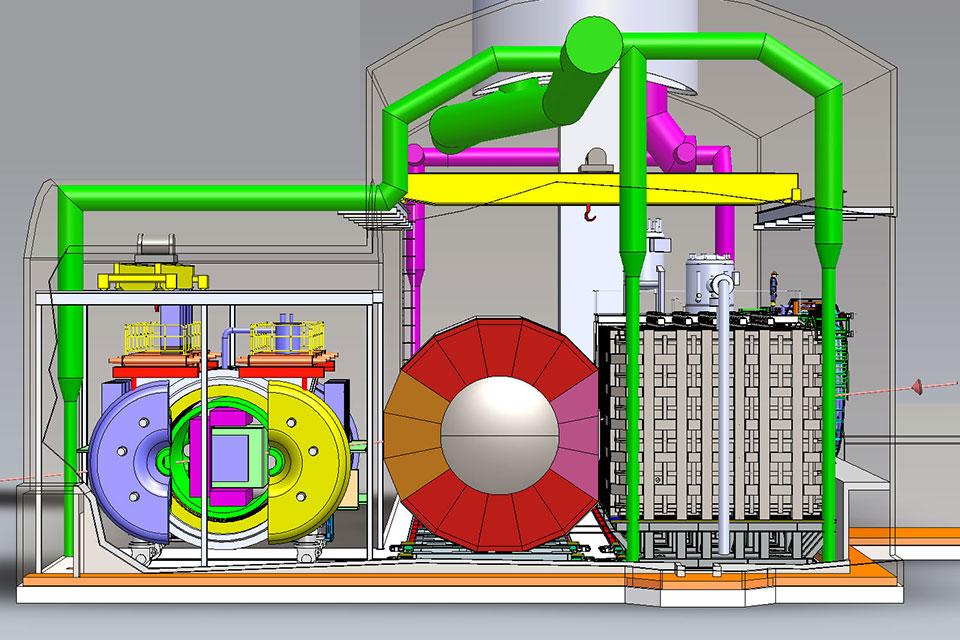As the Deep Underground Neutrino Experiment (DUNE) reveals more details about its so-called ‘near detector’ at Fermilab, we take a look at what it is and what it might mean for physics.
DUNE’s near detector at Fermilab, just outside Chicago, will take vital measurements of neutrino beam energy and composition before it reaches the experiment’s far detector in South Dakota, 800 miles away. It is all part of the project’s aims to get the two particle detectors working in tandem in an attempt to provide new insights into the unbalanced mixing of matter and antimatter. The experiment could unlock the mysteries of matter and how it was formed in our universe.
Understanding neutrinos
Although abundant, each individual neutrino is almost massless and a century ago, physicists didn’t know of their existence. Nevertheless, they shape many aspects of the universe as we know it which helps to explain the scale and ambition of DUNE – the project brings together more than 1,000 researchers from around the world.
DUNE will use the two particle detectors to measure how the neutrinos morph, or oscillate, as they travel through space, matter and time. The DUNE near detector will measure the neutrinos and observe how they interact before they oscillate while the DUNE far detector, to be located at the Sanford Underground Research Facility in South Dakota, will observe them after oscillation.
‘Billions of neutrinos can cross through you without ever realising it so they are very hard to get hold of and study,’ comments Professor Alfons Weber from the Department of Physics at Oxford who is playing a key role in making the DUNE near detector a reality. ‘The oscillation process is studied by measuring a beam at a near and far side and comparing the two measurements. This requires a powerful near detector system and, along with Fermilab’s Alan Bross and Professor Hirohisa Tanaka from the SLAC National Accelerator Laboratory, we have been leading the DUNE near detector design study which has culminated in the publication of the conceptional design report.’
Three subdetector systems
Building on lessons learned from previous experiments, the detector designs have become more sophisticated. The DUNE near detector, to be installed about 600 metres from where the neutrinos are produced in Fermilab’s accelerators, will consist of three subdetectors that will sit side by side.

One of the subdetectors, known as SAND and lead by Stanco, with its 15,000 kilometres (9,320 miles) of scintillator fibres and its 5,000 photomultipliers, will detect neutrinos with an electronic calorimeter, which measures particle energy, and a tracker, which records particle movements. A second subdetector, based on the ArgonCube technology developed at the University of Bern in Switzerland, will use liquid argon for the same purpose, and the third will use gaseous argon. Working together, they will measure particles with more precision than other neutrino detectors have able to achieve.
SAND will sit directly in the path of the neutrino beam to measure its stability and composition. The two argon-based detectors, meanwhile, will be moveable, able to sit either directly in the beam’s path or to be angled to one side. The different viewing angles will allow those detectors to measure how neutrino interactions change as the particles’ energies change.
Reconstructing information
The liquid-argon subdetector will function the same way as DUNE’s much larger far detector: when neutrinos interact with the liquid argon, the interaction will create charged particles that will be detected by electronics components that amplify, digitise and then send signals to a computer where the information contained in the signals can be reconstructed.
Professor Weber continues: ‘Several earlier generations of neutrino experiments have led to an evolution in neutrino detector design. When the detectors for those earlier experiments were designed, we had no idea how poorly we understood how neutrinos interact and all the different effects that we need to study to make a robust measurement.’
Professor Tanaka, whose SLAC team will provide key components of the liquid-argon subdetector, continues: ‘We always talk about neutrinos being elusive and difficult to detect; you see only a few of them and only very rarely.’ However, the opposite will apply to the near detector; there, ‘the neutrino beam we’re producing is so intense that in the liquid-argon subdetector we’ll see something like 50 interactions within millionths of a second,’ he added. The challenge therefore is to identify individual neutrinos, their energies and their types at a rate that matches the flood of neutrinos the near detector will see.
Capturing data
To capture such data, the liquid-argon subdetector will consist of an array of 35 nearly independently functioning smaller modules. Each in the array will have a mass of about three tons. When high voltage is applied to the liquid argon volume, the otherwise passive electrons in the argon atoms become liberated and start moving toward an array of detection elements.
Liquid argon — cooled to that state from its gaseous form — is so dense that the lowest-energy particles escape its detection. To capture those escaped particles, the argon-gas subdetector sits next to its liquid-argon counterpart. Far fewer neutrino interactions will happen in the argon gas because of its lower density.
Professor Weber continues: ‘You can measure other things in the argon-gas subdetector that you can’t measure in the liquid-argon subdetector.’ This includes measuring the effects of neutrino interactions on argon nuclei, a process that creates uncertainty in neutrino oscillation measurements.
Search for new particles
The three subdetectors working in combination will make it possible for physicists to look for phenomena that go beyond the bounds of known physical laws. As Fermilab’s Main Injector particle accelerator generates neutrinos that pass through the DUNE near detector, Professor Weber point out that, ‘other particles might get produced as well, particles that we don’t know anything about yet which is an incredibly exciting prospect.’
Heavy neutrinos and dark photons fall into this category. The existence of heavy neutrinos could explain the perplexing fact that the known neutrinos have a tiny mass, and their discovery could help explain the nature of dark matter. Dark photons would be the invisible cousins of regular photons, which are electromagnetic particles. The detection of dark photons — if they exist — could illuminate the expansive but currently invisible dark sector part of the universe.
The international Deep Underground Neutrino Experiment is supported by the Department of Energy Office of Science.

